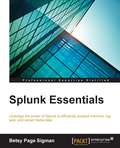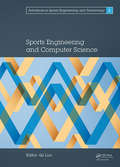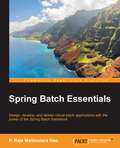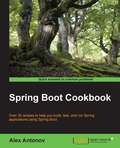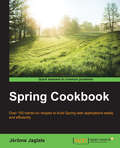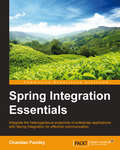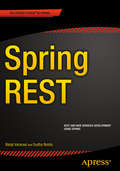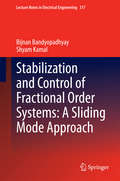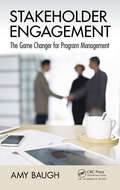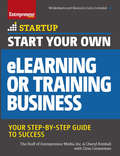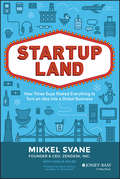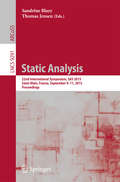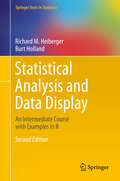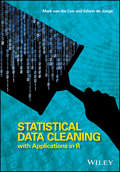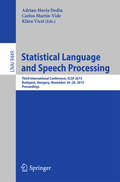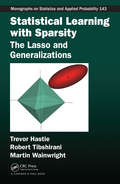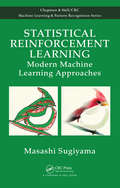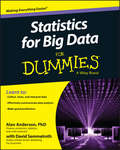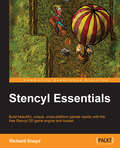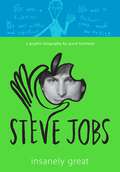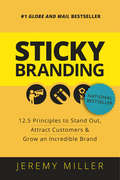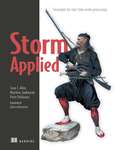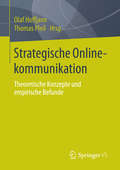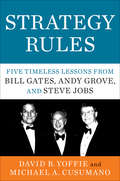- Table View
- List View
Splunk Essentials
by Betsy Page SigmanThis book is intended for a business person, analyst, or student who wants to quickly learn how to use Splunk to manage data. It would be helpful to have a bit of familiarity with basic computer concepts, but no prior experience of Splunk is required.
Sports Engineering and Computer Science: Proceedings of the International Conference on Sport Science and Computer Science (SSCS 2014), Singapore, 16-17 September 2014 (Advances in Sports Engineering and Technology)
by Qi LuoSports Engineering and Computer Science contains papers presented at the 2014 International Conference on Sport Science and Computer Science (SSCS 2014), held September 16-17, 2014 in Singapore and at the 2014 International Conference on Biomechanics and Sports Engineering (BSE 2014), held October 24-25, 2014, in Riga, Latvia. The contributions hav
Spring Batch Essentials
by P. Raja RaoIf you are a Java developer with basic knowledge of Spring and some experience in the development of enterprise applications, and want to learn about batch application development in detail, then this book is ideal for you. This book will be perfect as your next step towards building simple yet powerful batch applications on a Java-based platform.
Spring Boot Cookbook
by Alex AntonovOver 35 recipes to help you build, test, and run Spring applications using Spring Boot About This Book * Learn to create different types of Spring Boot applications, configure behavior, and add custom components * Become more efficient in testing, deploying, and monitoring Spring Boot based applications * This is a practical guide that will help Spring developers to develop and deploy applications using Spring Boot Who This Book Is For If you are a Spring Developer who has good knowledge level and understanding of Spring Boot and application development and now want to learn efficient Spring Boot development techniques in order to make the existing development process more efficient, then this book is for you. What You Will Learn * Create Spring Boot applications from scratch * Configure and tune web applications and containers * Create custom Spring Boot auto-configurations and starters * Use Spring Boot Test framework with JUnit, Cucumber, and Spock * Configure and tune web applications and containers * Deploy Spring Boot as self-starting executables and Docker containers * Monitor data using DropWizard, Graphite, and Dashing In Detail Spring Boot is Spring's convention-over-configuration solution. This feature makes it easy to create Spring applications and services with absolute minimum fuss. Spring Boot has the great ability to be customized and enhanced, and is specifically designed to simplify development of a new Spring application. This book will provide many detailed insights about the inner workings of Spring Boot, as well as tips and recipes to integrate the third-party frameworks and components needed to build complex enterprise-scale applications. The book starts with an overview of the important and useful Spring Boot starters that are included in the framework, and teaches you to create and add custom Servlet Filters, Interceptors, Converters, Formatters, and PropertyEditors to a Spring Boot web application. Next it will cover configuring custom routing rules and patterns, adding additional static asset paths, and adding and modifying servlet container connectors and other properties such as enabling SSL. Moving on, the book will teach you how to create custom Spring Boot Starters, and explore different techniques to test Spring Boot applications. Next, the book will show you examples of configuring your build to produce Docker images and self-executing binary files for Linux/OSX environments. Finally, the book will teach you how to create custom health indicators, and access monitoring data via HTTP and JMX. Style and approach This book is a cohesive collection of recipes that provide developers with a set of connected guidelines on how to build, configure, and customize their application, starting from the design and development stages, all the way through testing, deployment, and production monitoring.
Spring Cookbook
by Jerome JaglaleThis book is for you if you have some experience with Java and web development (not necessarily in Java) and want to become proficient quickly with Spring.
Spring Integration Essentials
by Chandan PandeyThis book is intended for developers who are either already involved with enterprise integration or planning to venture into the domain. Basic knowledge of Java and Spring is expected. For newer users, this book can be used to understand an integration scenario, what the challenges are, and how Spring Integration can be used to solve it. Prior experience of Spring Integration is not expected as this book will walk you through all the code examples.
Spring REST
by Balaji Varanasi Sudha BelidaLearn how to build clients that consume REST services. Discover Spring Boot, Spring MVC, Spring Data JPA, and Spring Security and the role they play in simplifying REST application development. Finally, see how to use the Spring MVC test framework to unit test and integration test your REST API. Spring REST is a practical guide for designing and developing RESTful APIs using the Spring Framework. This book walks you through the process of designing and building a REST application while taking a deep dive into design principles and best practices for versioning, security, documentation, error handling, paging, and sorting. After reading this book, you will come away with all the skills to build sophisticated REST applications using Spring technologies. What you'll learn How to build REST applications with Spring technologies How to identify REST resources and design their representations How to version REST services How to document REST services using Swagger How to handle errors and communicate meaningful messages How to secure REST services using Basic Auth and OAuth 2. 0 How to handle large data sets using pagination How to build REST clients using RestTemplate How to test REST services using the Spring MVC test framework Who this book is for This book is for enterprise and web developers using Java and Spring and want to build REST applications. The book requires a basic knowledge of Java, Spring and the web, but no prior exposure to REST. Table of Contents 1. Introduction to REST 2. Spring MVC Primer 3. RESTful Spring 4. Beginning the QuickPoll Application 5. Error Handling 6. Documenting REST Services 7. Versioning, Paging, and Sorting 8. Security 9. Clients and Testing 10. HATEOAS Appendix: Installing cURL on Windows
Stabilization and Control of Fractional Order Systems: A Sliding Mode Approach
by Bijnan Bandyopadhyay Shyam KamalIn the last two decades fractional differential equations have been used more frequently in physics, signal processing, fluid mechanics, viscoelasticity, mathematical biology, electro chemistry and many others. It opens a new and more realistic way to capture memory dependent phenomena and irregularities inside the systems by using more sophisticated mathematical analysis. This monograph is based on the authors' work on stabilization and control design for continuous and discrete fractional order systems. The initial two chapters and some parts of the third chapter are written in tutorial fashion, presenting all the basic concepts of fractional order system and a brief overview of sliding mode control of fractional order systems. The other parts contain deal with robust finite time stability of fractional order systems, integral sliding mode control of fractional order systems, co-operative control of multi-agent systems modeled as fractional differential equation, robust stabilization of discrete fractional order systems, high performance control using soft variable structure control and contraction analysis by integer and fractional order infinitesimal variations.
Stakeholder Engagement: The Game Changer for Program Management (Best Practices in Portfolio, Program, and Project Management #18)
by Amy BaughStrong stakeholder engagement is perhaps the most critical factor for achieving successful program execution in our fast-paced world. Many program managers get stuck in the "science" of program management, spending vast amounts of effort on tasks, charts, and metrics. Program managers who emphasize activities around relationship building and stakeh
Start Your Own eLearning or Training Business
by The Staff of Entrepreneur Media Ciree LinsenmannPossibly credited to advancements in technology or learning behaviors, or a rise in focus on personal development, the education and training industry is steadily growing, creating a demand for eager entrepreneurs. Exploring varied opportunities aspiring business owners will be given business ideas, teaching and training methods, and an overview of essential tools. A range of industry examples will be given for: Accreditation, certifications, and credit Adding training onto an existing business as side income How to sell media/training tools How much to charge clients Start up costs Software types used The legal obligations around taxes, business registration, working from home, and content confidentiality Growth planning and writing a business planRelevant and fun call-outs, tip boxes, industry stats, an index, and a rich appendix and glossary will be provided. Appendix will offer resources in: Continued learning and rounded training for trainers Industry organizations and trade groups Books and eBooks Videos Software Websites Successful online trainers and online education institutions Consultants Certification organizationsTeaching methods and tools will cover: Videos eBooks Interactive software types College sponsored staff training for college instructors Hardware, camera, video, sound equipment Online group forums Online events Choosing the right presentation style and linking to appropriate social media sites Networking presentations
Startupland: How Three Guys Risked Everything to Turn an Idea into a Global Business
by Carlye Adler Mikkel SvaneThe real story of what it takes to risk it all and go for broke. Conventional wisdom says most startups need to be in Silicon Valley, started by young engineers around a sexy new idea, and backed by VC funding.<P><P> But as Mikkel Svane reveals in Startupland, the story of founding Zendesk was anything but conventional. Founded in a Copenhagen loft by three thirty-something friends looking to break free from corporate doldrums, Zendesk Inc. is now one of the hottest enterprise software companies, still rapidly growing with customers in 150 countries. But its success was anything but predestined. With revealing stories both funny and frank, Mikkel shares how he and his friends bravely left secure jobs to start something on their own, how he almost went broke several times, how they picked up themselves and their families to travel across the world to California and the unknown, and how the three friends were miraculously still together for Zendesk's IPO and (still growing) success. Much like Zendesk's mission itself--to remove friction, barriers, and mystery in order to make customer service easier and more approachable--Startupland removes some of the myths about startups and startup founders. Mikkel's advice, hard-won through experience, often bucks conventional wisdom and entrepreneurial tropes. He shares why failure (whether fast or slow) is awful, why a seemingly boring product or idea can be the most exciting, why giving back to the community is as important as the bottom line. From how to hire right (look for people who are not offended by swearing) to which personas generate the highest response rates, Mikkel answers the most pressing questions from the perspective of someone still in the trenches and willing to share the hard truth, warts and all. While there are books by consultants who tell you how to build businesses, or by entrepreneurs now running billion-dollar businesses, there are few books from people still in the trenches who acutely remember the difficult daily decisions, the thrill (and fears) of the early days, the problems that scale with growing a business, and the reason why they all went on the adventure in the first place. Startupland is indispensable reading for all entrepreneurs who want to make their ideas the next big thing. The book will inspire and empower you to follow your own dream and create your own story.
Static Analysis
by Sandrine Blazy Thomas JensenThis book constitutes the refereed proceedings of the 22nd International Static Analysis Symposium, SAS 2015, held in Saint-Malo, France, in September 2015. The 18 papers presented in this volume were carefully reviewed and selected from 44 submissions. All fields of static analysis as a fundamental tool for program verification, bug detection, compiler optimization, program understanding, and software maintenance are addressed, featuring theoretical, practical, and application advances in the area
Statistical Analysis and Data Display
by Richard M. Heiberger Burt HollandThis contemporary presentation of statistical methods features extensive use of graphical displays for exploring data and for displaying the analysis. The authors demonstrate how to analyze data--showing code, graphics, and accompanying tabular listings--for all the methods they cover. They emphasize how to construct and interpret graphs. They discuss principles of graphical design. They identify situations where visual impressions from graphs may need confirmation from traditional tabular results. All chapters have exercises. The authors provide and discuss R functions for all the new graphical display formats. All graphs and tabular output in the book were constructed using these functions. Complete R scripts for all examples and figures are provided for readers to use as models for their own analyses. This book can serve as a standalone text for statistics majors at the master's level and for other quantitatively oriented disciplines at the doctoral level, and as a reference book for researchers. In-depth discussions of regression analysis, analysis of variance, and design of experiments are followed by introductions to analysis of discrete bivariate data, nonparametrics, logistic regression, and ARIMA time series modeling. The authors illustrate classical concepts and techniques with a variety of case studies using both newer graphical tools and traditional tabular displays. The Second Edition features graphs that are completely redrawn using the more powerful graphics infrastructure provided by R's lattice package. There are new sections in several of the chapters, revised sections in all chapters and several completely new appendices. New graphical material includes: * an expanded chapter on graphics * a section on graphing Likert Scale Data to build on the importance of rating scales in fields from population studies to psychometrics * a discussion on design of graphics that will work for readers with color-deficient vision * an expanded discussion on the design of multi-panel graphics * expanded and new sections in the discrete bivariate statistics capter on the use of mosaic plots for contingency tables including the n×2×2 tables for which the Mantel-Haenszel-Cochran test is appropriate * an interactive (using the shiny package) presentation of the graphics for the normal and t-tables that is introduced early and used in many chapters The new appendices include discussions of R, the HH package designed for R (the material in the HH package was distributed as a set of standalone functions with the First Edition of this book), the R Commander package, the RExcel system, the shiny package, and a minimal discussion on writing R packages. There is a new appendix on computational precision illustrating and explaining the FAQ (Frequently Asked Questions) about the differences between the familiar real number system and the less-familiar floating point system used in computers. The probability distributions appendix has been expanded to include more distributions (all the distributions in base R) and to include graphs of each. The editing appendix from the First Edition has been split into four expanded appendices--on working style, writing style, use of a powerful editor, and use of LaTeX for document preparation.
Statistical Data Cleaning with Applications in R
by Edwin De Jonge Mark van der LooA comprehensive guide to automated statistical data cleaning <p><p> The production of clean data is a complex and time-consuming process that requires both technical know-how and statistical expertise. Statistical Data Cleaning with Applications in R brings together a wide range of techniques for cleaning textual, numeric or categorical data. This book examines technical data cleaning methods relating to data representation and data structure. A prominent role is given to statistical data validation, data cleaning based on predefined restrictions, and data cleaning strategy.
Statistical Language and Speech Processing
by Carlos Martín-Vide Adrian-Horia Dediu Klára VicsiThis book constitutes the refereed proceedings of theThird International Conference on Statistical Language and Speech Processing,SLSP 2015, held in Budapest, Hungary, in November 2015. The 26 full papers presented together with twoinvited talks were carefully reviewed and selected from 71 submissions. Thepapers cover topics such as: anaphora and coreference resolution; authorshipidentification, plagiarism and spam filtering; computer-aided translation;corpora and language resources; data mining and semantic Web; informationextraction; information retrieval; knowledge representation and ontologies;lexicons and dictionaries; machine translation; multimodal technologies;natural language understanding; neural representation of speech and language;opinion mining and sentiment analysis; parsing; part-of-speech tagging;question-answering systems; semantic role labelling; speaker identification andverification; speech and language generation; speech recognition; speechsynthesis; speech transcription; spelling correction; spoken dialogue systems;term extraction; text categorisation; text summarisation; and user modeling.
Statistical Learning with Sparsity: The Lasso and Generalizations (Chapman & Hall/CRC Monographs on Statistics and Applied Probability)
by Trevor Hastie Robert Tibshirani Martin WainwrightDiscover New Methods for Dealing with High-Dimensional DataA sparse statistical model has only a small number of nonzero parameters or weights; therefore, it is much easier to estimate and interpret than a dense model. Statistical Learning with Sparsity: The Lasso and Generalizations presents methods that exploit sparsity to help recover the underl
Statistical Reinforcement Learning: Modern Machine Learning Approaches (Chapman & Hall/CRC Machine Learning & Pattern Recognition)
by Masashi SugiyamaReinforcement learning (RL) is a framework for decision making in unknown environments based on a large amount of data. Several practical RL applications for business intelligence, plant control, and gaming have been successfully explored in recent years. Providing an accessible introduction to the field, this book covers model-based and model-free approaches, policy iteration, and policy search methods. It presents illustrative examples and state-of-the-art results, including dimensionality reduction in RL and risk-sensitive RL. The book provides a bridge between RL and data mining and machine learning research.
Statistics Using IBM SPSS: An Integrative Approach
by Sharon Lawner Weinberg Sarah Knapp AbramowitzWritten in a clear and lively tone, Statistics Using IBM SPSS provides a data-centric approach to statistics with integrated SPSS (version 22) commands, ensuring that students gain both a deep conceptual understanding of statistics and practical facility with the leading statistical software package. With 100 worked examples, the textbook guides students through statistical practice using real data and avoids complicated mathematics. Numerous end-of-chapter exercises allow students to apply and test their understanding of chapter topics, with detailed answers available online. The third edition has been updated throughout and includes a new chapter on research design, new topics (including weighted mean, resampling with the bootstrap, the role of the syntax file in workflow management, and regression to the mean), and new examples and exercises. Student learning is supported by a rich suite of online resources, including answers to end-of-chapter exercises, real data sets, PowerPoint slides, and a test bank. Avoids calculus and linear algebra and instead grounds concepts in real data examples to ensure simple and clear explanation. Written by highly experienced teachers. Chapter examples and exercises are based on real data, which enables students to understand what it truly means to be a data analys.
Statistics for Big Data For Dummies
by David Semmelroth Alan AndersonThe fast and easy way to make sense of statistics for big data Does the subject of data analysis make you dizzy? You've come to the right place! Statistics For Big Data For Dummies breaks this often-overwhelming subject down into easily digestible parts, offering new and aspiring data analysts the foundation they need to be successful in the field. Inside, you'll find an easy-to-follow introduction to exploratory data analysis, the lowdown on collecting, cleaning, and organizing data, everything you need to know about interpreting data using common software and programming languages, plain-English explanations of how to make sense of data in the real world, and much more. Data has never been easier to come by, and the tools students and professionals need to enter the world of big data are based on applied statistics. While the word "statistics" alone can evoke feelings of anxiety in even the most confident student or professional, it doesn't have to. Written in the familiar and friendly tone that has defined the For Dummies brand for more than twenty years, Statistics For Big Data For Dummies takes the intimidation out of the subject, offering clear explanations and tons of step-by-step instruction to help you make sense of data mining--without losing your cool. Helps you to identify valid, useful, and understandable patterns in data Provides guidance on extracting previously unknown information from large databases Shows you how to discover patterns available in big data Gives you access to the latest tools and techniques for working in big data If you're a student enrolled in a related Applied Statistics course or a professional looking to expand your skillset, Statistics For Big Data For Dummies gives you access to everything you need to succeed.
Stencyl Essentials
by Richard SneydIf you are a computer game enthusiast who has always wanted to know what it takes to build a playable game, or maybe you would like to expand your programming knowledge so that you can develop great computer games using a solid game engine and toolkit, then this book is for you.
Steve Jobs: Insanely Great
by Jessie HartlandWhether they&’ve seen Aaron Sorkin and Danny Boyle&’s Steve Jobs movie, read Walter Isaacson&’s biography, or just own an iPhone, this graphic novel retelling of the Apple innovator&’s life will capture the imaginations of the legions of readers who live and breathe the technocentric world Jobs created. Told through a combination of black-and-white illustrations and handwritten text, this fast-paced and entertaining biography in graphic format presents the story of the ultimate American entrepreneur, the man who brought us Apple Computer, Pixar, Macs, iPods, iPhones, and more. Jobs&’s remarkable life reads like a history of the personal technology industry. He started Apple Computer in his parents&’ garage and eventually became the tastemaker of a generation, creating products we can&’t live without. Through it all, he was an overbearing and demanding perfectionist, both impossible and inspiring. Capturing his unparalleled brilliance, as well as his many demons, Jessie Hartland&’s engaging biography illuminates the meteoric successes, devastating setbacks, and myriad contradictions that make up the extraordinary life and legacy of the insanely great Steve Jobs.Here's the perfect book for any teen interested in STEM topics, especially tech. A School Library Journal Best Book of the Year &“If a picture is worth a thousand words, then this comic tale can hang with the sprawling biographies.&” —Macworld.com &“An accessible take . . . undoubtedly valuable for kids who are growing up using Apple&’s products but knowing little about the man who created them.&” —GeekDad.com
Sticky Branding: 12.5 Principles to Stand Out, Attract Customers, and Grow an Incredible Brand
by Jeremy Miller#1 Globe and Mail Bestseller 2016 Small Business Book Awards — Nominated, Marketing category Sticky Brands exist in almost every industry. Companies like Apple, Nike, and Starbucks have made themselves as recognizable as they are successful. But large companies are not the only ones who can stand out. Any business willing to challenge industry norms and find innovative ways to serve its customers can grow into a Sticky Brand. Based on a decade of research into what makes companies successful, Sticky Branding is your branding playbook. It provides ideas, stories, and exercises that will make your company stand out, attract customers, and grow into an incredible brand. Sticky Branding’s 12.5 guiding principles are drawn from hundreds of interviews with CEOs and business owners who have excelled within their industries.
Storm Applied: Strategies for real-time event processing
by Matthew Jankowski Peter Pathirana Sean AllenSummaryStorm Applied is a practical guide to using Apache Storm for the real-world tasks associated with processing and analyzing real-time data streams. This immediately useful book starts by building a solid foundation of Storm essentials so that you learn how to think about designing Storm solutions the right way from day one. But it quickly dives into real-world case studies that will bring the novice up to speed with productionizing Storm.Purchase of the print book includes a free eBook in PDF, Kindle, and ePub formats from Manning Publications.SummaryStorm Applied is a practical guide to using Apache Storm for the real-world tasks associated with processing and analyzing real-time data streams. This immediately useful book starts by building a solid foundation of Storm essentials so that you learn how to think about designing Storm solutions the right way from day one. But it quickly dives into real-world case studies that will bring the novice up to speed with productionizing Storm.About the TechnologyIt's hard to make sense out of data when it's coming at you fast. Like Hadoop, Storm processes large amounts of data but it does it reliably and in real time, guaranteeing that every message will be processed. Storm allows you to scale with your data as it grows, making it an excellent platform to solve your big data problems.About the BookStorm Applied is an example-driven guide to processing and analyzing real-time data streams. This immediately useful book starts by teaching you how to design Storm solutions the right way. Then, it quickly dives into real-world case studies that show you how to scale a high-throughput stream processor, ensure smooth operation within a production cluster, and more. Along the way, you'll learn to use Trident for stateful stream processing, along with other tools from the Storm ecosystem.This book moves through the basics quickly. While prior experience with Storm is not assumed, some experience with big data and real-time systems is helpful.What's InsideMapping real problems to Storm componentsPerformance tuning and scalingPractical troubleshooting and debuggingExactly-once processing with TridentAbout the AuthorsSean Allen, Matthew Jankowski, and Peter Pathirana lead the development team for a high-volume, search-intensive commercial web application at TheLadders.Table of ContentsIntroducing StormCore Storm conceptsTopology designCreating robust topologiesMoving from local to remote topologiesTuning in StormResource contentionStorm internalsTrident
Strategische Onlinekommunikation
by Olaf Hoffjann Thomas PleilOnlinekommunikation und speziel Social Media sind als besonders wichtige Herausforderungen des Kommunikationsmanagements erkannt. Kaum ein Unternehmen verzichtet mittlerweile auf die Beobachtung von Diskussionen im Internet und die Umsetzung eigener Kommunikationsstrategien im Social Web. Dort verändern sich für die PR und die Organisationskommunikation zentrale Aspekte: Öffentlichkeiten können heute sehr viel schneller entstehen. Es sind neue Formen der Meinungsbildung zu beobachten, die zunehmend weniger den Mechanismen der Massenkommunikation folgen, sondern Ergebnis netzwerkartiger Prozesse sind. In diesem Umfeld entstehen gleichzeitig neue Formen der Beteiligung, die durch entsprechende niederschwellige Instrumente im Internet erst ermöglicht werden. Aus Organisationssicht verändern sich damit unter anderem Entstehung und Pflege von Reputation oder das Management von Stakeholderbeziehungen. Zehn Jahre nach Beginn der Fachdiskussion zu PR und sozialen Medien gibt dieser Band auf Basis aktueller Untersuchungen Einblick in die Praxis und in aktuelle Herausforderungen der Organisationskommunikation im Internet.
Strategy Rules
by David B. Yoffie Michael A. CusumanoBetween 1968 and 1976, Bill Gates, Andy Grove, and Steve Jobs launched three companies that would define the world of high technology, create more than a trillion dollars in value, and transform our lives. How did they realize these incredible achievements? Strategy Rules examines these three individuals collectively for the first time--their successes and failures, comonalities and differences--revealing the business strategies and practices they pioneered while building their firms.Eminent business professors David Yoffie and Michael Cusumano have studied these three leaders and their companies for nearly thirty years, while teaching business strategy, innovation, and entrepreneurship at Harvard Business School and the MIT Sloan School of Management. In this enlightening guide, they show how Gates, Grove, and Jobs became masters of strategy. As CEOs, each approached strategy and execution in remarkably similar ways--yet markedly differently from their erstwhile competitors--keeping their focus on five rules: Look Forward, Reason Back: They determined where they want their companies to be in the future and could "reason back" to identify the moves that would take them there. Make Big Bets, Without Betting the Company: All three men made enormous strategic bets but rarely took gambles that put the financial viability of their companies at undue risk. Build Platforms and Ecosystems: Technology leaders have to create industry platforms that enable other firms to create complementary products and services that make the platforms increasingly valuable. Exploit Leverage and Power: Gates, Grove, and Jobs often turned opponents' strengths into weaknesses and used enormous resources (once they had them) to dominate competitors. Shape the Company around Your Personal Anchor: From Gates' understanding of software to Grove's devotion to process discipline and Jobs' obsession with design, all three built their companies around their personal strengths while compensating for their weaknesses.Strategy Rules brings together the best practices in strategic management and high-tech entrepreneurship, providing unique insights for start-up executives as well as the heads of modern multinationals.
